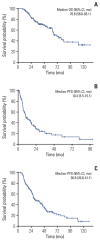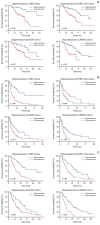Optimal Definition of Oligometastasis Showing Survival Benefits of Local Therapies during Tyrosine Kinase Inhibitor Treatment
- PMID: 36470259
- PMCID: PMC10101786
- DOI: 10.4143/crt.2022.1342
Optimal Definition of Oligometastasis Showing Survival Benefits of Local Therapies during Tyrosine Kinase Inhibitor Treatment
Abstract
Purpose: We aimed to investigate the feasibility of four criteria on oligometastasis (OM) concerning clear survival benefits of local therapy (LT) during tyrosine kinase inhibitor (TKI) treatment in non-small cell lung cancer (NSCLC).
Materials and methods: This single-center, retrospective study included patients with advanced NSCLC who received LT because of OM during TKI treatment at Asan Medical Center from January 2011 to December 2020. At the application of LT OM was classified according to four criteria: TNM, European Organization for Research and Treatment of Cancer Lung Cancer Group (EORTC-LCG), National Comprehensive Network (NCCN), and ORGAN. We compared survival outcomes between patients with and without OM.
Results: The median overall survival of the 117 patients included in the analysis was 70.8 months (95% confidence interval [CI], 56.6 to 85.1). The patients with OM meeting all four criteria (hazard ratio [HR] with 95% CI of TNM criteria 0.24 with 0.10-0.57; p=0.001, EORTC-LCG criteria 0.34 with 0.17-0.67; p=0.002, NCCN criteria 0.41 with 0.20-0.86; p=0.018 and ORGAN criteria 0.33 with 0.18-0.60; p < 0.001) had significantly longer survival compared with patients who did not after adjusting for confounding factors. Furthermore, increasing the number of extra-thoracic metastatic organs to two or more were independent predictive factors for worse survival outcomes (2 organs: HR, 3.51; 95% CI, 1.01 to 12.14; p=0.048; 3 organs: HR, 4.31; 95% CI, 0.94 to 19.73; p=0.060; 4 organs: HR, 24.47; 95% CI, 5.08 to 117.80; p < 0.001).
Conclusion: Patients with OM defined by all four criteria showed prognostic benefits from LT during TKI therapy.
Keywords: Lung neoplasms; Metastasis; Non–small cell lung carcinoma; Prognosis; Radiotherapy.
Conflict of interest statement
Jae Cheol Lee was supported by the Korea Medical Device Development Fund [Grant No. 202011B13]. The funder had no role in the design of the study, data collection and analysis, or manuscript preparation. The remaining authors have no potential conflicts of interest.
Figures



References
-
- Hellman S, Weichselbaum RR. Oligometastases. J Clin Oncol. 1995;13:8–10. - PubMed
-
- Siegel RL, Miller KD, Fuchs HE, Jemal A. Cancer statistics, 2021. CA Cancer J Clin. 2021;71:7–33. - PubMed
-
- Camidge DR, Pao W, Sequist LV. Acquired resistance to TKIs in solid tumours: learning from lung cancer. Nat Rev Clin Oncol. 2014;11:473–81. - PubMed
-
- Li XY, Zhu XR, Zhang CC, Yu W, Zhang B, Shen TL, et al. Analysis of progression patterns and failure sites of patients with metastatic lung adenocarcinoma with EGFR mutations receiving first-line treatment of tyrosine kinase inhibitors. Clin Lung Cancer. 2020;21:534–44. - PubMed
-
- Xu Q, Zhou F, Liu H, Jiang T, Li X, Xu Y, et al. Consolidative local ablative therapy improves the survival of patients with synchronous oligometastatic NSCLC harboring EGFR activating mutation treated with first-line EGFR-TKIs. J Thorac Oncol. 2018;13:1383–92. - PubMed
MeSH terms
Substances
Grants and funding
LinkOut - more resources
Full Text Sources
Medical

